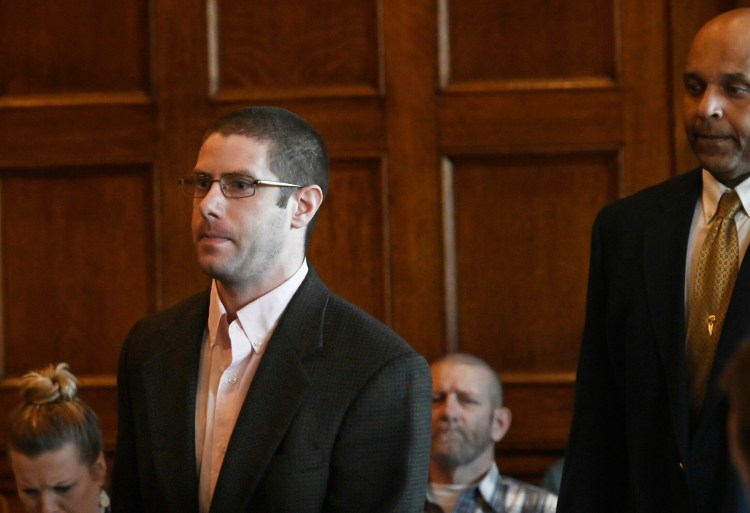The gold buttons on the tan shirt were fastened. The patches were still sewn onto the short sleeves. The clear plastic bag did not hide the red-brown stains.
The jury looked at the uniform shirt Cpl. Eugene Cole was wearing on the night he died in Norridgewock last April. It was now evidence in the trial of John D. Williams, who is charged with murder in the sheriff’s deputy’s death.
Assistant Attorney General Leane Zainea held the shirt in its bag up for a scientist from the state police crime lab, who sat on the witness stand Wednesday in the Cumberland County Courthouse in Portland.
Kimberly James, who leads the firearms unit at the lab, said her tests detected lead residue on the tip of the shirt collar on the right side, below the place the medical examiner identified as the entrance wound on Cole’s neck.
“What is the significance of the lead being present as we see here?” Zainea asked.
“It does tell me that the gun was fired in very close proximity in this area,” James said.
Cole, 61, was the first Maine police officer fatally shot in the line of duty in three decades. Williams, 30, was arrested outside a remote Fairfield cabin on the fourth day of a massive manhunt. He has pleaded not guilty.
The defense team has not denied Williams shot and killed Cole. But attorney Verne Paradie has argued that Williams was too high from drug use that night to intentionally or knowingly cause Cole’s death, which is a central element of a murder charge. Paradie has said he will ask the judge to instruct the jury on a lesser charge of manslaughter before it deliberates on the evidence. The possible sentence for murder is 25 years to life, while manslaughter is capped at 30 years.

Cpl. Eugene Cole
Forensic testimony dominated most of the third day of the high profile trial. Experts in blood, DNA analysis and firearms took the stand to explain what they found on evidence collected in the case. Those items – the uniform shirt, ammunition, guns – formed a pile in their clear plastic bags on a table in the front of the courtroom.
Alison Gingras identified most of the stains on the uniform shirt as blood.
“Can you point out for us where you saw the splatter staining?” Zainea asked.
“There’s one stain on the sleeve just forward of the stripes,” said Gingras, pointing to minuscule dots on the right sleeve. “And another stain on the upper right front.”
While the defense attorneys asked few questions of the witnesses from the lab, Paradie did press about the presence of DNA on the muzzle of the gun that is believed to be the one used in the shooting.
While DNA analyst Jennifer Sabean found DNA matching Cole and Williams on other pieces of evidence, a swab on the muzzle of the gun was not conclusive. Zainea said in her opening statement that evidence will suggest the gun was touching or very close to Cole’s skin when it was fired.
“You didn’t confirm any of the deputy’s DNA on the swab of the muzzle of the gun?” he asked.
“That is true,” Sabean said.
The jury also heard from law enforcement officers who were part of the arrest, and they watched a video of the police interview with Williams from that day.
The judge considered a longer version of that video in the months leading up to trial, but barred the jury from watching the second half because Williams became too tired.
Still, the jurors heard Williams confess to the shooting during his conversation with two Maine State Police detectives. During the video, Williams was still wearing the yellow tarp that police fastened around his waist when they walked him out of the woods earlier that afternoon. His voice was raspy and hard to hear at times, and his head slumped toward his handcuffed wrists.
In the courtroom, the jurors and Williams himself followed the conversation on typewritten transcripts, flipping from one page to the next. They watched as the detectives on screen brought Williams a blanket, a fast food burger and juice.
He eventually told the detectives that he went to the house of a woman he called his stepmom in hopes of borrowing a car. He was trying to get into the locked door when Cole pulled into the driveway and approached him. Cole asked his name, and when Williams identified himself, the sheriff’s deputy said he was under arrest.
Williams told the detectives in that interview that Cole then reached for him.
“I defended myself,” he said in the video.
“You defended yourself?” Detective Jason Andrews asked.
“I couldn’t understand why I was being arrested,” Williams said.
Williams told police that he pulled his handgun from the holster on his hip. Cole retreated and fell, and then Williams shot him in the head.
“I’m not going to buy this, ‘I have to defend myself,’ ” Andrews said later in the interview.
“I didn’t have to,” Williams said,
“Yeah, there you go,” Andrews said.
“I chose to,” Williams said.
“If nothing else, I appreciate that you’re willing to take that ownership,” Andrews said.
The day of testimony ended with the video. The state has presented more than 20 witnesses so far. It is still unclear if Williams will take the stand when the state rests its case.
The trial will resume Thursday.
Comments are not available on this story.
Send questions/comments to the editors.



